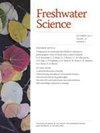Have stream diatom assemblages changed a decade after the loss of a foundation riparian tree species in a headwater Appalachian watershed?
IF 1.6
4区 环境科学与生态学
Q3 ECOLOGY
引用次数: 0
Abstract
Terrestrial and stream ecosystems are interconnected, with changes in one system cascading to affect the other. Tree mortality related to nonnative pest infestation has increased, yet we do not understand the effects that riparian tree species losses will have on the structural characteristics of stream ecosystems. We compared riparian canopy cover, algal standing crop, and diatom assemblage composition in 8 southern Appalachian headwater stream reaches within the Coweeta Hydrologic Laboratory in North Carolina, USA, before and after a massive die-off of riparian eastern hemlock (Tsuga canadensis [L.] Carr.) related to the introduction of hemlock woolly adelgid (Adelges tsugae Annand), an invasive insect. We analyzed historical preserved algal samples collected prior to hemlock die-off, in both summer (September 2005) and winter (January 2006), and used multivariate analyses to compare them to samples collected in the same 8 reaches and seasons 13 y following hemlock die-off (2018–2019). We predicted that increased canopy openness following hemlock death would change light availability and lead to higher standing crop and increases in the relative biovolume of high-profile diatoms. Contrary to our expectations, we found little difference in canopy cover and lower algal standing crop 13 y post-hemlock die-off, likely due to increased basal area of the understory shrub, Rhododendron maximum L., that replaced shade cover formerly provided by hemlock. Diatom assemblages were dominated by acidophilic taxa (e.g., Eunotia spp.) across all stream reaches before and after hemlock die-off. We observed some shifts in diatom assemblage composition, but the relative biovolume of a majority of the top 20 most abundant taxa, including Eunotia incisa W. Sm. ex W. Greg., Nupela lapidosa (Krasske) Lange-Bert., and Meridion alansmithii Brant (an endemic taxon), remained relatively unchanged 13 y after hemlock mortality. Diatom assemblages differed post-hemlock die-off in summer but not winter due to a decrease in the relative biovolume of Eunotia metamondon complex and an increase in the relative biovolume of Eunotia rhomboidea complex. Our study highlights the relative stability of diatom assemblage composition in southern Appalachian streams and the importance of long-term studies following a major riparian disturbance.在阿巴拉契亚上游流域失去一种基础河岸树种的十年后,溪流中的硅藻组合是否发生了变化?
陆地生态系统和河流生态系统是相互关联的,一个系统的变化会连锁影响另一个系统。与非本地害虫侵染相关的树木死亡率增加,但我们不了解河岸树种损失将对河流生态系统结构特征产生的影响。在美国北卡罗莱纳州Coweeta水文实验室内,我们比较了东部铁杉(Tsuga canadensis [L.])大规模死亡前后,美国南部阿巴拉契亚山脉8个源头河段的河岸冠层覆盖、藻类生长作物和硅藻组合组成。[Carr.])与引进一种入侵昆虫——铁杉绵蚜(Adelges tsugae Annand)有关。我们分析了铁杉死亡前夏季(2005年9月)和冬季(2006年1月)收集的历史保存藻类样本,并使用多变量分析将其与铁杉死亡后相同8个河段和季节(2018-2019年)收集的样本进行比较。我们预测,铁杉死亡后冠层开度的增加会改变光照利用率,导致高姿态硅藻的相对生物体积增加。与我们的预期相反,我们发现在铁杉死亡后,冠层覆盖和低赤潮直立作物13的差异不大,这可能是由于林下灌木杜鹃(Rhododendron maximum L.)的基底面积增加,取代了铁杉以前提供的遮荫覆盖。在铁杉枯死前后的所有河段,硅藻组合以嗜酸类群(如Eunotia spp.)为主。我们观察到硅藻组合组成发生了一些变化,但前20个最丰富的分类群中大多数的相对生物体积都发生了变化,包括Eunotia incisa W. Sm。前W.格雷格。兰格-伯特。在铁杉死亡13 y后,其分布基本保持不变。铁杉死后硅藻群落在夏季有明显的差异,但在冬季无明显差异,这是由于铁杉复合群落的相对生物量减少,而菱形复合群落的相对生物量增加。我们的研究强调了阿巴拉契亚南部河流中硅藻组合组成的相对稳定性,以及在主要河岸扰动后进行长期研究的重要性。
本文章由计算机程序翻译,如有差异,请以英文原文为准。
求助全文
约1分钟内获得全文
求助全文
来源期刊

Freshwater Science
ECOLOGY-MARINE & FRESHWATER BIOLOGY
CiteScore
4.10
自引率
0.00%
发文量
49
审稿时长
6-12 weeks
期刊介绍:
Freshwater Science (FWS) publishes articles that advance understanding and environmental stewardship of all types of inland aquatic ecosystems (lakes, rivers, streams, reservoirs, subterranean, and estuaries) and ecosystems at the interface between aquatic and terrestrial habitats (wetlands, riparian areas, and floodplains). The journal regularly features papers on a wide range of topics, including physical, chemical, and biological properties of lentic and lotic habitats; ecosystem processes; structure and dynamics of populations, communities, and ecosystems; ecology, systematics, and genetics of freshwater organisms, from bacteria to vertebrates; linkages between freshwater and other ecosystems and between freshwater ecology and other aquatic sciences; bioassessment, conservation, and restoration; environmental management; and new or novel methods for basic or applied research.
 求助内容:
求助内容: 应助结果提醒方式:
应助结果提醒方式:


